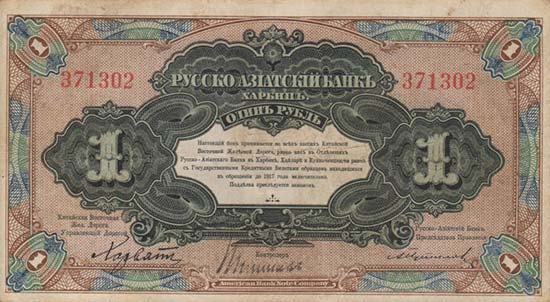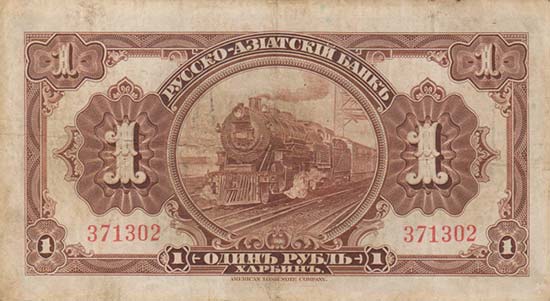Banknotes of the Russo-Asiatic Bank

Occasionally I saw these notes on eBay and was intrigued by the issuer name and also by the design. I purchased two of them (50 Kopeks and 1 Ruble denominations) and tried to find the story behind this issue. Below is short summary from different sources (mostly translated from Russian).


In 1895, the Russian government founded the Russo-Chinese Bank to help Russian capital enter the Chinese market and to finance construction of a Chinese Eastern Railway. The Russo-Asiatic bank was created in 1910 by merging the Russo-Chinese Bank with the Banque du Nord (a subsidiary of the Societe Generale). The new bank got vast network of branches in Russia from Banque du Nord, and access to Far East markets from the Russo-Chinese Bank. It also holds Russo-Chinese Bank’s rights to the Chinese Eastern Railway. A. I. Pitilov was appointed Chairman of the bank.
In the following years, the Russo-Asiatic Bank became the biggest commercial bank in Russia. In the beginning of 1917, the bank controlled more than 160 companies, including strategic military industry enterprises.
After the October Revolution the banks branches on Russian territory were nationalized. However, branches in China continued operations under same name. A. I. Putilov moved from St. Petersburg to China and continued to work as the banks chairman.
During the Russian Civil War (1917 - 1922) the Chinese Eastern Railway was an important supply area for the White Army. De-facto it becomes independent territory with Lt. General Horvat as a governor. At the time of civil war the Chinese Eastern Railway area remained relatively stable and peaceful.
In the beginning of 1918, the government of the Chinese Eastern Railway area faced an acute shortage of banknotes. At that time, only banknotes of the Russian Empire were circulating in the area. To solve this problem, the decision was made to issue banknotes from the Russo-Asiatic Bank. In the middle of 1918 banknotes for the total amount of 20 million roubles was ordered from the American Bank Note Company. This amount was divided as follows:
- 0.5 Rouble (50 Kopek) -- 500,000 Roubles (1,000,000 banknotes)
- 1, 3, and 10 Roubles -- 7,500,000 Roubles (exact distribution by denomination unknown)
- 100 Roubles -- 12,000,000 Roubles (120,000 banknotes)
Banknotes were issued by the Harbin branch of the Russo-Asiatic Bank. The printed banknotes arrived in Harbin in the last days of 1918. The issue of new banknotes was announced in the “Amur Outfall” newspaper as follows:
Harbin, December 30
The Russo-Asiatic Bank issues into circulation U.S. Printend banknotes of 50 Kopeks, as well as 1, 3, 10, and 100 Roubles with signatures of the bank's executive director Putilov and the Genaral Manager of the Chinese Eastern Railway General Horvat, for a total amount of 20,000,000 Roubles; banknotes are fully backed by Russian Empire credit roubles. The bank and Railway Management guarantees free acceptance of these banknotes on par with national banknotes. The order for banknotes was made in September due to an acute shortage of low denomination banknotes.
On these banknotes was the statement that they are accepted at all ticket offices of the Eastern Chinese Railway, as well as in the offices of the Russo-Asiatic Bank in Harbin, Hailar, and Kuanchentszy on par with Russian Empire State Credit Notes.
The high print quality of the notes, their anti-counterfeit features, and the fact that they were backed by the well-known Russo-Asiatic Bank lead to a high level of acceptance by the local population, both Russian and Chinese. All issued notes bear the signatures of Putilov and General Horvat. In addition, all notes except for the 50 Kopek denomination bear the signature of the Bank's Comptroller Pimenov, and the 100 Rouble denomination banknotes had a fourth signature – they were signed by one of six members of the bank's management board. The fourth signature on the 100 Roubles banknotes caused a long delay in putting them into circulation – the process of signing all 120,000 notes took more than two months.
These banknotes were in active circulation in 1919. In the beginning of 1920, the railway administration began to gradually withdraw banknotes of the Russo-Asiatic Bank from circulation. By Order Nr. 170 of the General Manager of Chinese Eastern Railway restrictions on acceptance of Russian Imperial Credit Notes and Russo-Asiatic Bank notes in railway's ticket offices were set. This basically marked the end of circulation for these notes.
Pick numbers for the banknotes:
- S473 50 Kopeks
- S474 1 Ruble
- S475 3 Rubles
- S476 10 Rubles
- S478 100 Rubles
Article Sources:
1. Book By A. I. Pogrebecky “Far East Banknotes during World War and Revolution (1914-1924)”
2. Article “History of Russo-Chinese Bank and Russo-Asiatic Bank”
3. Wikipedia Article "Русско-Азиатский банк"





